GAI-Tronics GSM Help Point Telephones User guide
- Category
- Mobile phones
- Type
- User guide
This manual is also suitable for

Doc. No. 502-20-0167-001 Issue 3, March 2018 (CN40117-056)
Installation and User Guide
GSM Help Point Telephone
GAI-TRONICS
.

2 GSM Help Point
CONTENTS
1.
Safety and Care Information ....................................................................... 4
2.
Product Description .................................................................................... 5
3.
Operation / Testing ..................................................................................... 7
3.1.
Making Calls using Memory Dial Buttons ..................................... 7
3.2.
Making Calls using Numeric Keypad ............................................ 7
3.3.
Receiving calls ............................................................................. 8
3.4.
Operating at extreme temperatures ............................................. 8
4.
Mounting & Installation ............................................................................... 8
4.1.
Prior to Installation ....................................................................... 8
4.2.
Important Notes for Installers and Maintainers ............................. 9
4.3.
Installation overview ................................................................... 10
4.4.
Mounting methods and dimensions ............................................ 10
5.
Connections & Set-up ............................................................................... 15
5.1.
Internal connections ................................................................... 15
5.2.
Installing the SIM ........................................................................ 15
5.3.
Battery connections .................................................................... 16
5.4.
Connecting the telephone .......................................................... 17
5.5.
LED indications and operating states ......................................... 17
5.6.
Switch on and test ...................................................................... 18
5.7.
Switching the phone off (power down) ....................................... 20
5.8.
Operating states of the phone .................................................... 20
6.
Programming, configuration and diagnostics ............................................ 20
6.1.
Sending Commands by SMS ..................................................... 21
6.2.
Sending Commands via USB port .............................................. 21
6.3.
List of Commands (for use with either SMS or USB) ................. 22
7.
Troubleshooting ........................................................................................ 36
7.1.
Phone not responding to 1234stat0 request via SMS: ............... 36

GSM Help Point 3
7.2.
ERROR light is permanently ON ................................................ 37
7.3.
ERROR light flashing Long/Fast ................................................ 37
7.4.
FUNCTION and ERROR lights flashing Long/Fast .................... 37
7.5.
FUNCTION and ERROR lights flashing Short/Slow ................... 37
8.
Maintenance ............................................................................................. 38
8.1.
Diagnostic check ........................................................................ 38
8.2.
Batteries ..................................................................................... 38
8.3.
Overdischarged batteries ........................................................... 39
8.4.
DC Power Adapter ..................................................................... 39
8.5.
Cleaning ..................................................................................... 39
8.6.
TMA............................................................................................ 40
9.
Aftercare ................................................................................................... 40
10.
Technical Specifications ........................................................................... 41
11.
Recycling information ............................................................................... 43
12.
CE Declaration ......................................................................................... 43

4 GSM Help Point
1. Safety and Care Information
▲
Please read these instructions thoroughly before starting installation.
These products must only be installed and maintained by competent
personnel familiar with electrical and telephone installation.
▲
IMPORTANT! This phone, like any wireless phone, operates using radio
signals and the wireless network, which cannot guarantee connection in
all conditions. Therefore, you should never rely solely upon any wireless
phone for essential communications (e.g. medical emergencies).
Remember, to make or receive any calls, the phone must be switched on,
appropriately configured and in an area with adequate cellular signal strength.
Emergency calls may not be possible on all wireless phone networks, when
certain network services or phone features are in use or on phones without a
full keypad unless an auto-dial button is programmed to call an emergency
number. Check with local cellular service providers. Emergency calls may be
made even when a SIM card is not installed (subject to network availability)
using a recognised emergency dialling code such as 112.
▲
Operating environment
Make sure that no special regulation is in force that imposes restrictions on
the use of mobile phones. Restrictions to mobile phones would also apply to
this telephone. Most modern electronic equipment is shielded from radio
frequency (RF) signals. However, certain electronic equipment may not be
shielded against the RF signals from your phone.
▲
Mains power supply
If a mains power supply unit (PSU) is used as the power source for the
telephone, it must be installed by a competent installer and must be provided
with a 2-pole disconnect device in accordance with EN 62368-1 Annex L.
▲
Pacemakers
Pacemaker manufacturers recommend that a minimum separation of 20 cm
(8 inches) be maintained between a handheld wireless phone and a
pacemaker. The same restriction should apply to the external antenna of this
phone, where fitted. If you have any reason to suspect that interference is
taking place, switch off the phone immediately.
▲
Hearing aids
The phone’s radio signals may interfere with some hearing aids. In such
cases move the antenna as far away as practical or consult your hearing aid
supplier.

GSM Help Point 5
▲
Other medical devices
Operation of any radio transmitting equipment, including the phone, may
interfere with the function of inadequately protected medical devices. Consult
a physician or the manufacturer of the medical device to determine if they are
adequately shielded from external RF energy or if you have any questions.
Switch off the phone in health care facilities when any regulations posted in
these areas instruct you to do so. Hospitals or health care facilities may be
using equipment that could be sensitive to external RF energy.
▲
Radio
transmission equipment
While GAI-Tronics GSM products are designed to conform to international
standards regarding the acceptance of radio frequency interference, certain
installation locations may interfere with their proper operation. We
recommend that GAI-Tronics GSM equipment is not installed in close
proximity to any equipment that generates RF signals (for example, radio
transmitters), and is located as far as possible away from it or in a separate
room.
▲
Potentially explosive atmospheres
Do not install the phone or site the antenna in any area with a potentially
explosive atmosphere and obey all signs and instructions. Areas with a
potentially explosive atmosphere are often but not always clearly marked.
They include chemical transfer or storage facilities; vehicles using liquefied
petroleum gas (such as propane or butane): areas where the air contains
chemicals or particles, such as grain, dust or metal powders.
2. Product Description
This manual describes GSM (cellular) versions of the Help Point and VR (Vandal
Resistant) hands-free telephone range. These units offer high degrees of
resistance to weather and abuse, having only a microphone, speaker and one or
more metal buttons mounted on a flat, metal faceplate, in place of a traditional
handset and keypad.
Models are available with auto-dial buttons for dialling pre-stored numbers from a
single button press, or with full numeric keypads for manual dialling. Common
panel layouts are shown below.

6 GSM Help Point
Main features include:
• Robust and weather resistant: IP65
• Range of keypad options
• Large, easy to see tactile buttons
• Programmable auto-dialler functions for dialling pre-stored numbers
• Auto-dial numbers are remotely programmable
• “Rollover” feature to try alternative numbers if the first autodial call
does not connect (1 and 2 button units only).
• Penta band WCDMA (3G), quad band GSM (2G) communication,
takes standard (2FF) 2G/3G SIM card (not supplied)
• A range of power supply options are available, including solar
• High capacity internal battery giving typically 6 hours talk time, 330
hours standby
• Remote programming and diagnostics via SMS
• Automatic acoustic path mic and speaker testing
• Flush or surface mounting (with rear enclosure)
• Simple installation
• Aluminium or stainless steel faceplate
• Waterproof speaker, protected by stainless steel mesh

GSM Help Point 7
• Sensitive microphone, protected by semi porous membrane and
metal grille
• Stainless steel push button(s)
• Call status LED
• Optional stainless steel rear enclosure
• Optional induction loop for the hearing impaired.
• Optional relay outputs (2)
For the full list of product features, please see the specifications in section 10
and configuration options in section 6. Note that most configuration options
are referred to by their command codes, usually stating with “CFG”.
3. Operation / Testing
Please note that, following power connection, there will be a delay while the
telephone acquires the network before it can make or receive calls.
3.1. Making Calls using Memory Dial Buttons
To make a call, press the required memory button and wait for connection.
When using a memory button, a brief bust of tones is heard to signify that the
call has been placed to the pre-programmed number.
If the phone is equipped with an ON/OFF button, calls can be ended by
pressing it.
If the phone has only memory dial buttons, calls can only be terminated by the
called party, or by expiry of the call duration timer (CFG6)
3.2. Making Calls using Numeric Keypad
If the phone is equipped with a numeric keypad, calls can be made by dialling
numbers manually.
To do this, first press the ON/OFF button, wait for dial tone (or the appropriate
call progress announcement message if pre-programmed) and then dial the
appropriate number. There is no “Send” button – the dialled number will be
sent to the network after the programmed dial delay (CFG1) or the maximum
number of digits has been entered (CFG12)
To end a call, press the ON/OFF button a second time.

8 GSM Help Point
3.3. Receiving calls
To receive a call, press a memory dial button or the ON/OFF button when
ringing is heard. The phone can also be configured to automatically answer
incoming calls (CFG26).
Note: It is possible to configure the phone to inhibit incoming calls (CFG5). If
so configured, the sounder will not sound, but the phone can still receive SMS
commands, acknowledge commands via SMS and communicate via USB.
3.4. Operating at extreme temperatures
The telephone has a wide operating temperature range, but there are some
points to note at the very extremes:
Cold temperature performance:
If the transmitter circuit is colder than -39°C when the phone is first turned on,
it will enter a warm up state. It is not possible to make or accept calls in the
warm up state. When the phone is operating, it will suspend low power
sleeping to prevent the transmitter circuit temperature falling below -38°C. The
power consumption will rise slightly to provide the required small level of
localised self-heating, in order to maintain the transmitter circuit at a
temperature of at least -39°C.
High temperature performance:
if the main PCB temperature is greater than 68°C when the phone is first
turned on, it will enter a protection state. It is not possible to make or accept
calls in the protection state. When the phone is operating, it will allow any non-
emergency calls to continue while the transmitter circuit is less than 91°C. For
emergency calls, there is no thermal restriction and the phone will continue the
emergency call which may result in irreversible damage to the circuit. This is
only likely to occur if the ambient temperature were significantly above 60°C.
4. Mounting & Installation
4.1. Prior to Installation
Please ensure the following steps are taken prior to installation:
• Survey the site to ensure there is adequate mobile network signal
coverage on the selected network.
• SIM card: Obtain a suitable, unlocked SIM card for the network
concerned – IMPORTANT: Ensure that the SIM is activated and not
locked. If the SIM is locked there may not be a way of unlocking it
from the telephone and it will not function. It is also recommended to
disable voicemail on the SIM.

GSM Help Point 9
• Power source. Ensure the chosen power source (for example solar
panel, 230V mains outlet, etc.) is available.
• Antenna location. The GSM Help Point is a metal-bodied
telephone and therefore the antenna needs to be mounted externally
to the telephone. Please ensure that there is a suitable mounting
location for the antenna and, if a remote antenna is used, that
suitable protection for the cable from the antenna to the telephone is
provided, for example conduit or trunking. A stainless steel rear
enclosure, with a pre-fitted antenna, is available for wall-mounting.
4.2. Important Notes for Installers and Maintainers
• Qualified personnel only
GSM Help Point telephones can be supplied with one of several
different power supply options which may require connection of the
power supply to an AC mains outlet. Installation and maintenance
must only be carried out by appropriately qualified and trained
personnel. Contact GAI-Tronics if installation service is required.
• DC power adapter
If a mains to DC power adapter is used, it must be an approved type
supplied by GAI-Tronics, and must be installed according to the
instructions provided with it. In particular it must be installed with a
2-pole disconnect device compliant with EN 62368-1 Annex L.
Contact GAI-Tronics for details of available power supply units.
• Test tools required
During the testing and commissioning of the GSM Help Point
telephone, the use of another mobile phone will be required in order
to send status and configuration commands via SMS text messages.
Alternatively, a laptop computer can be used connected to the
internal USB port, see section 6.2.
• Avoid contamination during installation
All possible measures must be taken to ensure water, fluid or dust
does not contaminate the internal components of the telephone
whilst unpacking, preparing and installing the telephone in inclement
weather conditions or by negligence. Failure to do so may invalidate
your warranty. Please retain any screws removed during installation
or maintenance - make sure the correct screws are refitted to ensure
the integrity of any seals.
• Emergency Services warning
If the telephone is configured so that it cannot make a direct call to
the emergency services, check with your telephone service provider
or infrastructure maintainer whether it is necessary to warn users,
and if so provide a suitable warning notice.

10 GSM Help Point
4.3. Installation overview
The GSM Help Point can be flush mounted (for example into a panel or
wall), or fitted into a dedicated rear enclosure enabling it to be surface
mounted or pole mounted.
1. The SIM holder, batteries and all connections are on the rear of the
faceplate, allowing the rear enclosure to be mounted first.
2. The telephone is intended for vertical installation to a wall or pole.
Select the required mounting method (section 4.4) and mount the rear
enclosure first where applicable.
3. Route the required cables (through glands as appropriate if using a rear
enclosure), install the SIM card, connect the battery and make
connections following section 5. Ensure that any cable entries are
sealed with either a gland or a black blanking plug as described.
4. Fit the faceplate ensuring a weatherproof seal
5. Programming or parameter changes can be made remotely, using SMS
(see section 6)
6. Test the operation of the telephone (section 3). Installation is now
complete.
4.4. Mounting methods and dimensions
Before mounting the telephone, check the cable routing and requirements. If
glands are required, fit them to the rear enclosure as follows:
1. One or two glands may be used – for example one for the antenna cable
and the other for power. If only one gland is used, ensure the supplied
blanking plug is left in place to seal the unused hole.
2. Note that 2 plastic glands are supplied, but it is the installer’s responsibility
to select the correct type of gland for the application and cables used. The
gland entries (and the supplied glands) are M20.
3. Select the appropriate sized gland:
Use the smaller gland for cables diameters 4 - 7mm.
Use the larger gland for cable diameters 8 - 13mm.
4. From the outside of the case, insert the selected gland into the cable entry
hole, fit the lock nut inside the enclosure and tighten, so that its sealing
washer is compressed against the outer surface of the enclosure as
shown:

GSM Help Point 11
5. Proceed with chosen mounting method below
4.4.1 Wall mounting (using a GAI-Tronics rear enclosure)
1. Mark the wall with hole centres based on the dimensions shown
(145 x 270mm). If necessary offer the rear enclosure up to the wall

12 GSM Help Point
to check alignment. Do not use the enclosure as a template for
drilling.
2. Drill holes in the wall on the marked positions. Select appropriate
screws, wall plugs etc., for the type of wall, bearing in mind that the
weight of the complete phone is around 5kg.
Ensure that the four supplied plastic flanged bushes are in place
(fitted from the inside) and the rear enclosure is screwed tightly to
the surface to prevent any water ingress through the mounting
holes.
WARNING:.Your warranty will be invalidated if :-
1. Any fixing hole in the rear enclosure is left unused.
2. Any additional holes are drilled into the telephone enclosure.
3. Plastic bushes are not used on all fixing holes.
3. Complete the installation by fitting the SIM, making the appropriate
connections (section 5) and re-fitting the face plate.
4.4.2 Pole mounting
Kit No 100-02-0208-001

GSM Help Point 13
This accessory is for mounting GAI-Tronics telephones on to the side of
round poles of 100mm to 200mm diameter, or on to square or
rectangular section uprights of 100mm to 150mm across the mounting
surface.
NOTE:
Banding straps (large scale worm-drive clamps) are not included in this
kit and must be obtained separately. For details of where banding can
be obtained, refer to GAI-Tronics.
1. Attach the pole mounting clamp assemblies to the rear enclosure
using the M6 x 25 screws provided, pushing the screws through
from inside the phone.
2. Tighten nuts to a torque of 4.5Nm max.
IMPORTANT: avoid the use of power tools. Spinning the nuts too
quickly can cause a rapid increase in heat which can cause the nuts
to seize as a result of galling or cold-welding.
Note: ensure that the screws seat properly in the plastic bushes to
avoid water ingress.
3. Ensuring that the glands are at the bottom, pass a proprietary
banding strap round each of the pole mounting clamps and the
support pole. Tighten securely.
4. Continue the installation by fitting the SIM, making the appropriate
connections (section 5) and re-fitting the face plate.
5. Re-tighten the straps firmly and trim off any excess band material.
For security the driving head of the band may also be sawn off.

14 GSM Help Point
4.4.3 Flush mounting
IMPORTANT:
If not mounted in a GAI-Tronics rear enclosure, the rear face of the
telephone must be installed so that its delicate components cannot be
damaged and to ensure that there is a minimum 10mm clearance
between them and any metal or conductive parts behind.
Note that it is the installer’s responsibility to prevent moisture coming
into contact with the electronics and connections on the back of the
faceplate.
To flush-mount the telephone to a wall:
1. Prepare a recess (50mm deep) in the wall according to the
dimensions shown.
2. Mark the wall with hole centres based on the dimensions shown
(166 x 307mm). If necessary offer the faceplate up to the wall to
check alignment. Do not use the telephone as a template for
drilling.
3. Drill holes in the wall at the marked positions. Select appropriate
screws, wall plugs etc., for the type of wall, bearing in mind that the
weight of the complete phone is around 1.5kg.
4. Route the cables to within the recess, fit the SIM and make
connections to the telephone as shown in section 5.

GSM Help Point 15
5. Secure the telephone to the wall taking care not to trap any wires.
Note that the gasket on the rear of the faceplate is intended to make
a weather seal when compressed against a smooth surface. Do not
rely on this gasket to keep water out if mounting directly to rough
surfaces such as brickwork – in these cases use additional sealant
around the edges to ensure a weatherproof seal.
5. Connections & Set-up
5.1. Internal connections
With the exception of the battery cable, the internal connections do not
need to be disconnected or disturbed during installation, but for
reference they are shown below:
5.2. Installing the SIM
IMPORTANT: before installing or changing a SIM card, always make
sure that the telephone is powered down by ensuring that both the DC
power source cable and the battery cable are disconnected from the
main PCB.
Carefully insert a SIM card into the holder:
Not used
Induction loop coils
Not used
Microphone
Speaker
Battery
Antenna
Not used
On/Off
button
USB
socket

16 GSM Help Point
5.3. Battery connections
The batteries are secured in recesses in the rear cover, with their
terminals protruding inside it. The telephone is shipped from the factory
with the battery cable disconnected. The batteries are linked and fused
as shown below.
Always ensure the batteries are connected before connecting the power
supply, or the batteries may not charge.
IMPORTANT
Batteries and battery fuses must only be replaced by skilled
personnel, only replaced with the correct parts supplied by GAI-
Tronics, and only connected as shown.
Please contact GAI-Tronics if installation, maintenance or assistance is
required.
CAUTION

GSM Help Point 17
Risk of explosion if batteries are replaced by an incorrect type.
Dispose of used batteries according to recycling instructions (section 11)
5.4. Connecting the telephone
The GSM Help Point telephone needs to be connected to an external
DC power source and a suitable antenna.
If glands are used, insert each cable through the gland body and tighten
the gland nut sufficiently to clamp the cable, making a seal. Ensure
sufficient cable is left to allow removal of the faceplate or front casing
without straining the cable.
IMPORTANT: If only one gland entry is used, the blanking plug fitted to
the second gland position must be left in place.
The antenna cable screws onto the SMA connector provided.
Connect the DC power source to the 2 pole terminal plug as shown,
noting that the positive terminal is the one adjacent to the red button.
Power requirement is 9-18V dc, 3.6W. The telephone can be connected
directly to a solar panel without the need for a charge controller.
When power is first connected, the Charge LED (see below) will light.
Always ensure the batteries are connected before connecting the power
supply, or the batteries may not charge.
5.5. LED indications and operating states
Located at the base of the main circuit board are three red LED
indicators that provide useful status information.
Note that, to save power, the LEDs will all go off after 5 minutes of
inactivity. Pressing the ON/OFF button briefly will reactivate the LEDs for
a further 5 minutes for diagnostic purposes.

18 GSM Help Point
The indicator functions are as follows:
• CHARGE - On whenever external power is first applied, flashes if
there is a fault such as battery not connected.
• FUNCTION - Indicates the current operation. See the table below.
• ERROR - Indicates problems with operation. See the table below.
FUNCTION
ERROR
Meaning
Off Off
Phone switched OFF.
(or power save mode – press ON/OFF button
briefly to be certain)
Short/fast Off Initialising/searching.
Short/slow Off Standby – ready for use.
Long/fast Off Incoming call.
On Off Call in progress.
Off Long/Fast SIM card is locked, PIN code required. *
Long/fast Long/Fast SIM card is blocked, PUK code required. *
Short/slow Short/slow Weak signal.
Off Short/slow Insufficient power to operate, but charging.
Off On Fault, such as no SIM.
On On Momentary indication to acknowledge a
press of the On/Off button
* It is not possible to rectify these faults from the telephone itself. Please ensure
that the SIM is not locked (or blocked) prior to use.
5.6. Switch on and test
1. Once the SIM card has been fitted and DC power connected, press
and hold the On/Off button located next to the power connector. The
FUNCTION and ERROR indicators will both light and will then go off,
when this occurs release the button. The FUNCTION indicator will

GSM Help Point 19
flash rapidly to indicate that the phone is initialising and is searching
for a valid mobile network.
2. After several seconds, the FUNCTION indicator should flash less
frequently to indicate that a call may be made or received. If there is
an error, for example no SIM installed, the ERROR indicator will light.
See the list above for a full list of indicator conditions.
3. Using a mobile phone, send an SMS status command to the phone
requesting the current status. Use the following format for your
outgoing message:
1234STAT
(where 1234 is the default PIN code.) The reply should be similar to
the following:
Signal: -93dBm
Vin:11.97V
Bat:4.58V
Temp
Now: 23
Min: 19
Max: 30
Humidity: 40%
Battery: OK
Audio test: Pass
Ver: 1.0
IMEI: 359998042484305
4. If all is well with the status response, record the information for
reference, to compare with later status reports.
5. Fit the faceplate:
a. Carefully place the faceplate onto its mounting flange, taking care
not to trap any cables.
b. Insert the 4 fixing screws and tighten.
c. Check that a good weatherproof seal exists between the
faceplate and rear enclosure or wall.
6. Make a call to the phone to ensure the sounder operates. Then make
an outgoing call from the phone to an external number. This will only
be possible on a phone with a full keypad otherwise auto-dial
numbers will first need to be programmed, see section 6.
For many installations, the steps outlined so far will result in a fully
functioning phone.
However, the GSM Help Point is also highly customisable for many
situations. Detailed configuration is made possible by either sending
specially formatted SMS messages from another phone or by

20 GSM Help Point
connecting a computer via the USB port. For details, please see section
6.
5.7. Switching the phone off (power down)
To power the phone down, press and hold the pushbutton until the
FUNCTION and ERROR indicators extinguish. The phone will now be in
the Off (Charge Only) state. If the phone is to be shipped or stored the
battery should then also be disconnected.
5.8. Operating states of the phone
GSM Help Point has the following operating states:
• On - The phone is fully powered and ready to make and receive
calls.
• Charge only - This is the state that the phone will enter when
external DC power is applied. If power is removed, the phone will
enter the “Off” state.
• Off - This is the state in which the phone is shipped from the factory
to prevent battery drain in transit and storage.
The SIM card should only be fitted or removed if the telephone is in the
OFF state.
If the phone is “Off” and has sufficient battery power or is in “Charge
only” mode, pressing the on/off pushbutton will put the phone into the
“On” state.
If the ERROR indicator is flashing Short/Slow, leave the external DC
power connected to fully charge the battery, or at least until the ERROR
indicator stops flashing.
Note: to fully charge the battery may take in excess of 5 hours
depending on the current charge state of the battery.
If the phone is “On” and the battery charge becomes exhausted, the
phone will turn off. Once the external DC supply is restored, the phone
will automatically enter the “On” state and also start charging the battery.
6. Programming, configuration and diagnostics
The GSM Help Point has numerous features that can be configured using
commands sent to it either via SMS messages from another phone or by a
computer connected to the internal USB port. Most commands entered via the
USB port are also accepted while the phone is in charge only mode, i.e.
switched off but still powered by an external DC power source.
Page is loading ...
Page is loading ...
Page is loading ...
Page is loading ...
Page is loading ...
Page is loading ...
Page is loading ...
Page is loading ...
Page is loading ...
Page is loading ...
Page is loading ...
Page is loading ...
Page is loading ...
Page is loading ...
Page is loading ...
Page is loading ...
Page is loading ...
Page is loading ...
Page is loading ...
Page is loading ...
Page is loading ...
Page is loading ...
Page is loading ...
Page is loading ...
-
 1
1
-
 2
2
-
 3
3
-
 4
4
-
 5
5
-
 6
6
-
 7
7
-
 8
8
-
 9
9
-
 10
10
-
 11
11
-
 12
12
-
 13
13
-
 14
14
-
 15
15
-
 16
16
-
 17
17
-
 18
18
-
 19
19
-
 20
20
-
 21
21
-
 22
22
-
 23
23
-
 24
24
-
 25
25
-
 26
26
-
 27
27
-
 28
28
-
 29
29
-
 30
30
-
 31
31
-
 32
32
-
 33
33
-
 34
34
-
 35
35
-
 36
36
-
 37
37
-
 38
38
-
 39
39
-
 40
40
-
 41
41
-
 42
42
-
 43
43
-
 44
44
GAI-Tronics GSM Help Point Telephones User guide
- Category
- Mobile phones
- Type
- User guide
- This manual is also suitable for
Ask a question and I''ll find the answer in the document
Finding information in a document is now easier with AI
Related papers
-
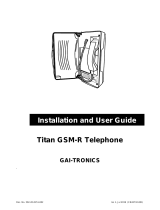 GAI-Tronics Titan GSM-R Telephone Installation guide
GAI-Tronics Titan GSM-R Telephone Installation guide
-
 GAI-Tronics PHP400 Help Point GSM 48 VDC User guide
GAI-Tronics PHP400 Help Point GSM 48 VDC User guide
-
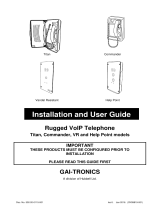 GAI-Tronics Rugged VoIP Telephone Titan, Commander, VR and Help Point s Installation guide
GAI-Tronics Rugged VoIP Telephone Titan, Commander, VR and Help Point s Installation guide
-
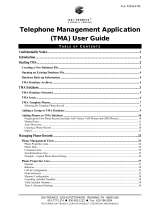 GAI-Tronics Telephone Management Application (TMA) User guide
GAI-Tronics Telephone Management Application (TMA) User guide
-
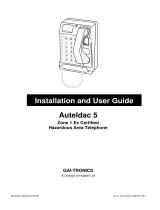 GAI-Tronics Auteldac 5 Hazardous Area Telephone User guide
GAI-Tronics Auteldac 5 Hazardous Area Telephone User guide
-
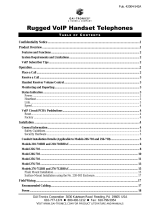 GAI-Tronics Rugged VoIP Handset Telephones Installation guide
GAI-Tronics Rugged VoIP Handset Telephones Installation guide
-
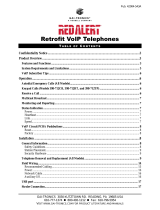 GAI-Tronics RED ALERT Hands-free VoIP Retro-Fit Telephones Installation guide
GAI-Tronics RED ALERT Hands-free VoIP Retro-Fit Telephones Installation guide
-
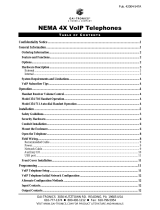 GAI-Tronics NEMA 4X VoIP Telephones Installation guide
GAI-Tronics NEMA 4X VoIP Telephones Installation guide
-
 GAI-Tronics VoIP Clean Phone Telephones (1193 Installation guide
GAI-Tronics VoIP Clean Phone Telephones (1193 Installation guide
-
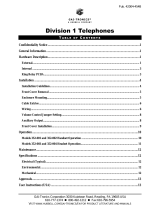 GAI-Tronics 352-001, 352-002, 352-003, 352-004 User guide
GAI-Tronics 352-001, 352-002, 352-003, 352-004 User guide
Other documents
-
HQTELECOM HQ-JWAT135 Operating instructions
-
Tellur TLL155641 User manual
-
Tellur TLL155601 User manual
-
Ortech PUK SS User manual
-
HQTELECOM HQ-JWAT137 Operating instructions
-
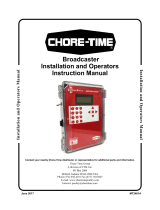 Chore-Time Broadcaster Installation and Operators Instruction Manual
Chore-Time Broadcaster Installation and Operators Instruction Manual
-
Motorola E365 User manual
-
Videx DIGITAL GSM DOOR INTERCOM SYSTEM Technical Manual
-
Videx GSM4KC Technical Manual
-
BURY CP 1000 CarPhone Owner's manual






















































